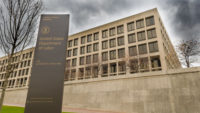The heart of the University of Arizona’s Applied Research Building in Tucson, on schedule for completion this month, is its 40-ton thermal vacuum chamber used to replicate the conditions in outer space. The chamber is the largest of its kind at any university. It is so massive that it was set in its place first and the rest of the three-story building grew up around it.
U of A claims the title of the top-ranked public research university in astronomy and astrophysics funding nationally. The university—whose planning, design and construction department was named ENR Southwest 2023 Owner of the Year—has been improving its space science research infrastructure and building facilities that can accommodate major research projects. Another project advancing its scientific research goals, the Grand Challenges Research Building, is also currently under construction.
The university selected a design-build team of McCarthy Building Cos. and SmithGroup for the $85-million Applied Research Building. “The building will be a showcase for cutting edge research and partnerships with NASA and other federal agencies,” says Mark Kranz, SmithGroup's vice president and design director.
A unique combination of specialized areas including the 24-ft-long thermal vacuum chamber, 40-ft-tall high bay payload assembly areas, two-story anechoic chamber, clean rooms and customized laboratories are designed for all aspects of satellite research, from fabrication to testing, to be performed inside.
The 89,000-sq-ft building is designed to “blend in while standing out,” Kranz says. The exterior has metallic panels toned to match bricks on campus, while also reflecting its space-age use. Built beside a busy pedestrian corridor, the building also offers a view of its space simulation chamber via the southwest-facing lobby, which is in turn protected from the harsh sun by a combination of vertical fins and gradient fritted glazing.
Construction started in mid-2021. The thermal vacuum chamber was placed on its own concrete slab that is structurally isolated and designed for spill protection. The chamber’s door is so heavy that it requires a caster apparatus to open via a track embedded in the slab. Mike Lee, project director at McCarthy, says the team used a shoring system to protect the chamber during construction, enclosing it in a wood box as work on the structure proceeded around it.
“Because of the size and the weight, we couldn’t wait to install it,” Lee says.
 The building's thermal vacuum chamber is the largest of its kind at a university. Photos: Left courtesy of McCarthy Building Cos., Right by Scott Blair/ENR
The building's thermal vacuum chamber is the largest of its kind at a university. Photos: Left courtesy of McCarthy Building Cos., Right by Scott Blair/ENR
Brian Brandis, architect and project manager for U of A’s planning design and construction department, says the design-build process facilitated a collaborative team dynamic. That allowed them to “provide the highest project value” through budgeting and scheduling, he adds.
Lee says early planning and partnerships with key trade partners avoided any workforce shortages. As supply chain issues affected the industry, the team was able to coordinate some material changes as needed. They also recognized market conditions and purchased needed electrical equipment in advance—it ended up taking 14 months to arrive.
“With early planning and early coordination, we were able to have the opportunity to get [the equipment] on site,” Lee says.
Renewable Energy
The Applied Research Building is set to be powered by renewable energy as part of an agreement between the university and local utility Tucson Electric Power, says Dana Sylvester, the university's construction project manager for the planning, design and construction department. TEP supplies power to the university from solar facilities located in southeast Tucson and wind power facilities in New Mexico.
Design strategies limit ventilation and maximize heat recovery, Kranz says. Some spaces have fine humidity control requirements, but those areas needing increased humidification were minimized to limit water and energy use. Large testing areas and clean rooms use local recirculation. These strategies, along with an efficient building envelope, allow improved energy performance, Kranz says.
“The University of Arizona is committed to designing and constructing high performance, energy efficient buildings intended to last 50 to 100 years,” Sylvester says.
Key Point on Campus
The building is located in a central spot on U of A’s campus, just off Speedway Boulevard, a main east-west thoroughfare for the university and the city. It also sits beside the Highland Corridor, a pedestrian and cyclist path connecting key points on campus.
University leaders did not want the Highland Corridor shut down during construction, so the team made a plan to temporarily reconfigure it around the site, Lee says. The low point of the corridor crossing under Speedway beside the building also created an “extremely challenging” situation for grading the site, Kranz says. The design incorporates retaining walls and ramping to balance the needs of accessibility, stormwater management and pedestrian movement.
 A pedestrian and cyclist corridor was temporarily reconfigured for construction, but ultimately rerouted to improve safety. Photo courtesy of McCarthy Building Cos.
A pedestrian and cyclist corridor was temporarily reconfigured for construction, but ultimately rerouted to improve safety. Photo courtesy of McCarthy Building Cos.
A tunnel carries the corridor under Speedway with one portal near the building site, and the project includes rerouting the corridor slightly to allow for the new building, as well as to improve safety and add an intersection for north-south and east-west pedestrian and cyclist traffic.
The site is not just a building, but also a key “part of the campus fabric,” says Peter Dourlein, university architect and associate vice president of planning, design and construction. That meant it was important to maintain open space and provide students with safe routes through campus.
“It’s where students bump into each other and people from other cultures," who speak different languages and are from many age groups and have different academic majors, Dourlein adds. “This project and the team made sure that the experience in this part of campus was achieving all those goals.”





Post a comment to this article
Report Abusive Comment